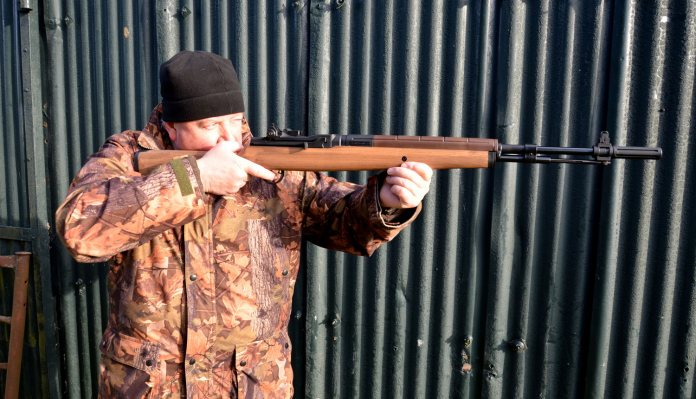Springfield Armoury M1A - Recognisable
-
0
 Comments
Comments
- Last updated: 09/04/2024

The replica firearms market is a popular route for many shooting enthusiasts, and there’s no doubt that many models make great display pieces. However, owning a gun that carries historical interest, as well as being a fully operational airgun, undoubtedly adds an extra layer to the pleasure of ownership.
Spring into action
On test here is just such a gun - the Springfield Armoury M1A, and with plenty of heft and a length of 46”, this is a full-size adult offering for sure. It’s manufactured by a company called Air Venturi, and with Sportsmarketing just recently being awarded the UK distribution rights, this brand’s nationwide availability should be assured. The M1A is a pretty good replica, visuals-wise, of the US service rifle that was famously used in the Vietnam War; based on the civilian version that was available. At 9.3 lbs in weight, it’s a bit of a beast, but considering that its design also conceals a highly functional spring piston power plant, it’s an appealing prospect whichever way you look at it.
Build quality
The copious use of compound material/plastics for much of the exterior helps to keep weight down, and that does slightly detract from the ‘first impressions’. Close inspection, however, reveals solidly made and reasonably well-finished components. OK, the brown plastic running over the top of the forend (in place of wooden sections on the original, which were designed to shield the hand from the heat of the barrel) is perhaps a bit crude, but overall, it just works. The stock is fashioned from hardwood, and whilst this is a bit plain and undeniably basic, it fits this model and mirrors the original. Let’s face it, military hardware is often designed to be basic, utilitarian, and functional above all else for reduced cost, so it’s a ‘no-frills’ specification if you like. That said, the light matte finish to the wood means some pleasant grain pattern is visible, and with a moulded grip piece at the butt, the profile overall feels about right.
Underlever action
To cock the spring piston action, the underlever up front is utilized, and with the lever itself designed to be telescopic, the process is all very manageable. Just pull it out to extend, unclip the lever, and then cock the action utilizing the extra leverage. Very clever, and in practice, it works well. The M1A is therefore very easy to cock, and as it goes through the stroke, the top plastic dummy wood section slides forward to reveal and expose the open sliding breech area, in much the same way as an HW77. Because of that, the golden rule needs to be adhered to when handling this type of exposed breech airgun, just to be ultra-safe. Basically, keep a tight grip on the underlever throughout the cocking process whilst the action is cocked and open. A pellet can then be fed directly into the lip of the rifling, and then as an added safety feature, the action is designed so that the lever can only be returned to close the breech, once the spring-loaded safety button is depressed, just to the left/rear side of the action. So yes, there are built-in safety features, but we are relying on small pieces of metal in the mechanism, so hold that lever! And if you own an HW77/ TX200, my advice is to look smart and do the same.
Sighting up
There is no provision for a scope on the M1A, but the same mounting points are on the side of the action that would be on the original as if they are there to accept a bolt-on rail. However, check the modest asking price, and remember that in practice, this is a model to be enjoyed using the boldly styled military peep sight arrangement. The rear unit features two large finger wheels, and whilst adjustment is a little crude, I managed to zero the M1A to shoot fairly near the bull on my target at 30 yards. Up front, the foresight is an open post protected by side panels, and this is to be centralized in the rear, circular ‘peep’ image. Shooting in failing light had me reaching for fluorescent Jack Pyke orange dot sticker targets, and with this far easier bull to aid sighting, I was rewarded with several groups over the distance of less than 1” c-t-c. That’s pretty good I would wager, in anyone’s book. No fibre optic elements are utilized here, so this is a classic case where a carefully placed splash of bright paint on the foresight element would pay dividends.
As for power and consistency, this model gave a good account of itself, producing an average of 10.9 ft/lbs of energy, and a 10-shot velocity string with a total spread of just 7 fps. The trigger is single stage and unsurprisingly, a little creepy. However, squeeze through, and take up the slack, and the actual pull weight is fairly light. The action is a bit twangy on firing as the spring resonates, but recoil is very mild, partly the result of the sheer mass of this model. Most springers will benefit from a full check-over, polish-up, and a gentle lubrication regime, applying the care and attention to detail that simply isn’t possible on the factory production line. The action and feel will greatly benefit as a result.
Conclusion
As it stands, the Springfield Armoury M1A still comes highly recommended. For the record, it’s only available in .22 calibre, but for those that appreciate the bold, semi-replica profile, it’s a whole lot of fun and is difficult to fault for the money.
Thanks to Range & Country Shooting Supplies in Sleaford, Lincs., for the kind loan of this airgun.
